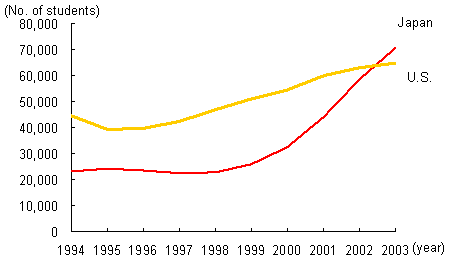China has sent many students overseas to study since it embarked on market-opening reforms. These students now hold leading positions in various sectors of society such as politics, business and the arts and sciences both at home and abroad. Among them, the active role played by those who studied in the United States is remarkable. This reflects the fact that the U.S., more than any other country, has accepted China's brightest students. However, since the 2001 terrorist attacks, it has become difficult to obtain U.S. visas and scholarships offered by American universities have decreased. As a result, more Chinese students are now looking to study in Japan instead of the U.S., and Japan has replaced the U.S. as the chief recipient of Chinese students ( diagram ).
Over the past several years, the number of foreign students Japan accepts has grown rapidly, and the aim of accepting 100,000 students by 2000 that was put forward by the then Prime Minister Yasuhiro Nakasone in 1983 has been achieved, albeit three years behind schedule. The engine behind this growth is the surge in students from China, and as of May 2003, the number of Chinese students grew 21% year-on-year to reach 70,814, accounting for 64.7% of the total figure (according to the Ministry of Education, Culture, Sports, Science and Technology). In contrast, the number of Chinese students going to the U.S. has not increased much in recent years, and in the 2002-2003 academic year the figure stood at 64,757, registering a scant year-on-year rise of 2.4 percentage points. Furthermore, considering the fact that the number of people who take the TOEFL test, which is seen as a prerequisite for studying in the U.S., is falling rapidly, a sharp decline in the number of new students who go to the U.S. in the future is inevitable. The reversal in the positions of Japan and the U.S. as the destination for Chinese students will most likely continue for the time being.
However, while the number of Chinese students Japan accepts has increased, there has been virtually no improvement in their quality or the quality of education that Japan offers. Coupled with the fact that the number of Japanophiles overseas is not growing, it is no exaggeration to say that Japan's foreign student policy has been a total failure. From the students' viewpoint, the research environment at Japanese universities is poor compared to that in the U.S. and Europe, and coupled with the language barrier and high cost of living, Japan is not necessarily an attractive place to study. If overseas study is a sort of investment to increase lifetime net income, studying in Japan is a very unprofitable investment that does not lead to promotion or increased income despite the high costs and risks.
When most Chinese students who go to study in the U.S. become pro-American and when they assume leading positions in their own country, it becomes very easy for the U.S. to carry out its diplomatic policy. On the business front, many Chinese who have studied in the U.S. are given opportunities at American firms, and play key roles in expanding their business operations in China. In contrast, while it is rare for Chinese youth who are likely to play future leadership roles to want to study in Japan in the first place, even these few are not sufficiently utilized by Japanese companies. Furthermore, as a result of reasons such as the difficulty of acquiring doctorates in the liberal arts, it is not unusual for Chinese students to become frustrated and return to China without gaining a favorable impression of Japan.
In order to improve the situation, when accepting foreign students, Japan should recognize the needs of the other party (demand factors) and the realities of its research and education systems (supply factors) and proceed in line with its comparative advantages. It should not rush to expand its foreign student quotas while its program for receiving them remains unprepared, because not only is this unbeneficial for the students, but it also does not serve Japan's national interests. The Japanese government and government ministries and agencies concerned should tackle this problem by shifting the focus of its foreign student policy from "quantitative expansion," as seen in the "100,000 Foreign Students Plan," to "quality improvement." The recent increase in the number of Chinese students who wish to study in Japan should be seen as an opportunity to attract "first-rate students" rather than just "more students."
It has long been said that China's brightest students study in the U.S., while second-rate students come to Japan. It is only natural for the best students to want to study at the best universities, and in order for first-rate foreign students to come to Japan, it is needless to say that Japanese universities must be first-rate as well. Unfortunately, there is still a large gap between ideals and reality, and in the ongoing university reforms which aim to change the situation, various problems still lie in the way.
(Note) Up until last year, some 30,000 people took the TOEFL test annually in the Beijing area, and in some years the figure even topped 100,000. However, the total number of people who took the test the four times it was administered this year amounted to roughly 10,000 (People's Daily Online, Japanese version, Nov. 17, 2003).

(Note)Figures for Japan as of May 1 every year; those for the U.S. are for the academic yar.
(Source)Ministry of Education, Culture, Sports, Science and Technology Website,http://www.mext.go.jp/a_menu/koutou/ryugau/index.htm
(Japanese Only) Open Doors ,http://www.iienetwork.org/ , Institute of International Education


